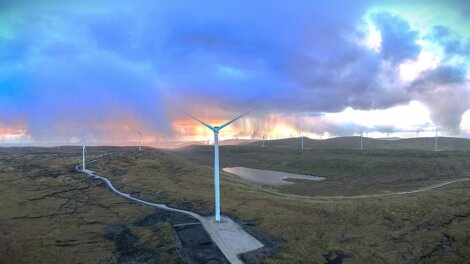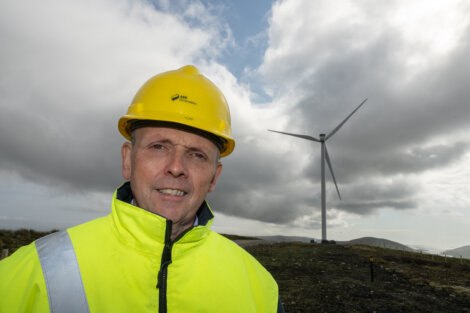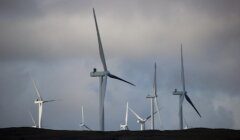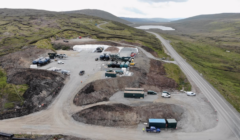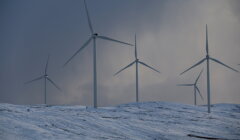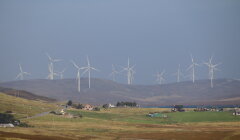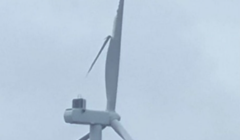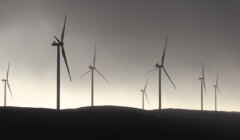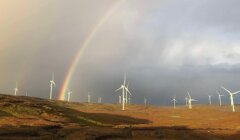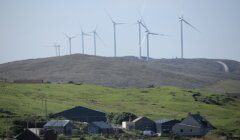Energy / SSE celebrates completion of Viking Energy wind farm
- The utility’s chief executive Alistair Phillips-Davies predicts huge benefits for the isles
- Cheap wind energy will stabilise electricity prices, according to SSE
- Company keen to develop further projects in the isles
SHETLAND IS going to reap huge benefits from becoming a green energy hub according to the chief executive of energy giant SSE.
Alistair Phillips-Davies and a team of senior managers from the utility were in in the isles on Wednesday to officially mark the completion of the Viking Energy wind farm and the associated 260 km subsea transmission link connecting Shetland with the national grid.
This means the wind farm is now in full commercial operation.
Phillips-Davies dismissed concerns over constraint payments to SSE for switching off the Viking wind farm when there is too much renewable energy generated in the north of Scotland as a “completely normal thing”.
Speaking during a media briefing at the Viking compound, he added that the company would be interested in developing more renewable energy projects in the isles.
While being sympathetic towards calls for a social tariff – or Shetland tariff – for islanders to help combat fuel poverty and compensate for hosting large industrial renewable energy developments in the isles, he said those complex issues were best tackled by the local community benefit fund.
Philipps-Davies also said it was crucial that the UK was developing its own energy generation capacity to become less vulnerable to volatile markets, and Viking – described as the most productive onshore wind farm in the UK – is to play a major part in that aspiration.
“This is a £1.2 billion investment in Shetland to rebuild an energy industry here that is dying because we are running out of oil and gas; it a fantastic opportunity for Shetland to showcase itself,” the chief executive said.
“The opportunities to be a fantastic green energy hub are there, so that is definitely worth celebrating.
“Also, the fact that within a year or two Shetland will be able to turn off the diesel generators in Lerwick, so the whole islands will become much greener. There is also the chance to green the remaining oil and gas industry. There are huge benefits.”
Become a member of Shetland News
The 103-turbine wind farm, which has been 20 years in the making and during that time created some bitter and long-lasting divisions in the community, started feeding electricity into the national grid earlier this summer.
As such SSE has been able to claim constraint payments during periods of time network operator National Grid requested energy generators produce less than they are contracted to either due to bottlenecks in the system or because demand was lower than expected.
Shetland News and other local media reported that for this month alone SSE has already been claiming more than £2 million in such payments.
Phillips-Davies said the balancing mechanism was a normal thing and had been operating for decades.
He added SSE was working on reducing the risk of renewable generation becoming stranded.
“We are building £20 billion worth of networks over the next few years to make sure we can take all the resources from the north of Scotland down to the central belt and further beyond,” the chief executive said.
Asked when consumers can finally expect lower electricity prices, he said the issue was for the UK to gain control over its own energy production so that “we will have far more stable prices, and potentially lower prices”.
Photo: Malcolm Younger/Millgaet Media
Phillips-Davies said: “For me the issue is that we won’t necessarily see the big spikes in prices that we have seen. This country needs to have control over its energy system.
“Gas prices have come down, but recently have gone up by 15 or 20 per cent which is why we see the energy price cap going up again.
“It is incumbent on us to make sure that we make investments so that we can control the price. The wind energy you are getting today is far cheaper than burning oil and gas in a power station.”
The chief executive said he was sympathetic to calls for a special energy tariff for islanders but suggested that Shetland is already receiving huge sums of subsidies for its electricity which currently is produced by burning very expensive diesel.
He also said that any discussions about a Shetland Tariff would need to involve competing interests from Holyrood, Westminster and the regulator Ofgem, and suggested that the Viking Community Benefit Fund, which will receive more than £2 million from SSE annually, might find easier ways to directly support those in fuel poverty.
“What I am sympathetic to is making sure communities benefit from hosting assets, but not to the extent that makes it uneconomic to bring in the assets in the first place,” he said.
“There is no doubt that Shetland gets huge subsidies from energy because you burn very, very expensive diesel currently.
“Equally, although the energy appears to be free because it is from wind, it is only free because we spent £500 million putting it here (…) and we are paying millions of pounds every year into a community benefit fund.”
Philipps-Davies added that with spare capacity left in the 600MW interconnector and the prospect of a second far larger subsea cable being built in the near future, the company “would be very interested to be doing further developments in the islands”.
“We will definitely be going to do the second transmission link,” he said, “and talking to Heather [Donald] [SSE Renewables’ director for construction and development of onshore wind projects in the UK and Ireland] earlier, [I know] she’s got her eye on bits of land for possible developments going forward.
“We have had great success here in Shetland, and if we could do more in Shetland that would be fantastic.”
Donald said: “We are always looking for projects, and first and foremost we are looking for sites in windy conditions and with grid capacity.
“We have nothing specific at the moment that I could share in terms of projects, but Shetland is an obvious place to be looking. Wind energy is the cheapest form of energy generation, so we are looking for projects all the time.”
Meanwhile, Scotland’s first minister John Swinney described the completion of the project as a “significant step in unlocking the green energy potential of the Shetland Islands”.
He said: “These developments will not only aid us in our efforts to decarbonise our energy system, but help to stimulate sustainable economic growth in the local area.
“It is welcome that Scotland’s onshore wind capacity continues to expand. This is a vital component of our mission to bring about a just transition to net zero.”
See also:





